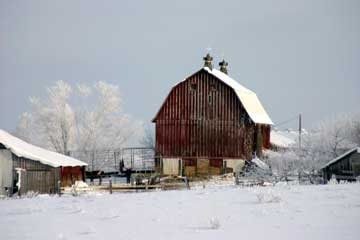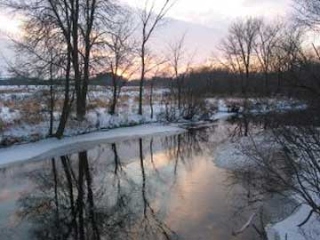Kinnickinnic River
Arguably the best trout stream in Wisconsin.The River
The Kinnickinnic River, called the Kinni for short, is a 25-mile-long river near River Falls, WI. The river rises from a series of spring holes in pastures three miles north of I-94 in St. Croix County, and flows southwest for about 22 miles until it empties into the St. Croix River at the Kinnickinnic State Park in Pierce County. It is joined by several spring creeks along its course (including Parker Creek, Kelly Creek, South Fork, and Rocky Branch) draining a watershed area of 170 square miles.
The Kinni watershed is characterized by scenic bluff lands, rare oak savanna, original prairie, farm land, white pine forest, wooded coulees, sedge meadows, rare and endangered plant species, beautiful stands of white pines and plenty of open space and scenic vistas. Its feeder creeks are cold and clean, containing wild native brook trout, important spawning areas, wetlands, and many springs arising from under picturesque limestone outcroppings.
In addition to its spectacular beauty, 200-foot deep canyon, and extraordinary water quality, the Kinni is a world-class wild brown trout fishery. It is probably the most productive trout stream in the entire Upper Mississippi River Basin. Listed as a Class I trout stream by the WI DNR, the river is one of the few naturally sustaining trout fisheries in the Midwest, producing both brook and brown trout. The entire river is a high-quality fishery, stocking was eliminated in 1974. Travel Wisconsin has named the Kinni as one of the top 5 trout streams in the State of Wisconsin.
The Kinni is classified as an “Outstanding Resource Water,” and is considered to be one of the premier Class I trout streams in the State of Wisconsin.
The Upper Kinni
Above the city of River Falls, the Upper Kinni flows slowly, with a sandy/silty bottom and a narrower bed. These upper stretches of the river and the feeder creeks harbor native brook trout and furnish terrific spawning grounds for browns. Numerous springs feed the Kinni and a number of tributaries and creeks play a major role in the river’s flow. Parker Creek, Nye Creek, Ted Creek and Kelly Creek are all found in the Upper Kinni watershed. Brown trout are the most abundant in the Kinni from I-94 south. The upper section of the river is a typical spring creek that contains very high numbers of trout that are of smaller size than the lower section.
Both brook and brown trout inhabit the upper Kinni. Thanks to fences that keep cattle out, the upper river meanders clean and clear over a rubble bottom through miles of farmland. Habitat improvements made by the WI DNR and Kiap-TU-Wish provide good cover. Natural reproductions boasts 5,000-12,000 per mile, some of the highest densities in the country. Access to the upper Kinni is relatively easy. There are 17 entry points between the spring ponds and Highway 35 at the north edge of River Falls. DNR easements and numerous road crossings provide adequate access.
The Lower Kinni
Below the City of River Falls, the Kinnickinnic River flows through the “Lower Kinni canyon” that begins about a mile below the city. Continuing approximately 10 miles to the St. Croix River where it flows into the delta of the Kinnickinnic State Park. It’s high cliffs, shaded rapids and numerous moss and fern clad rock outcroppings provide habitat for abundant wildlife and numerous plants and vegetation (some of which are on the threatened list).

Peter Davis on the Kinni ©Meyer Creative
The Lower Kinni, has a stream bed that is wider and is generally composed of stone rather than sand or silt. A substantial amount of silt and sand are deposited in the delta, enough that that section of the St. Croix is known as the “Kinnickinnic Narrows.” The lower portion of the Kinni is more like a freestone stream – rubble-strewn with dark pools at the bends, long, challenging flats, and a succession of riffles. The lower river flows over a bed of fragmented limestone and gravel through steep, wooded canyon. The wide valley makes this stretch popular among local fly fisherman. Trout are fewer, but larger. Lofty bluffs cause wide shadows over the sand, gravel and rubble bottom. The Kinni winds for eight miles below River Falls before passing beneath County Trunk Highway F.
The slightly warmer water below River Falls supports more minnow and crustacean life, which can support larger trout (though in fewer numbers), than the upper reaches. In the lower–more fertile reaches–browns are bigger and less frequent, but still plentiful. Although the occasional brook trout can be found, mostly brown trout inhabit the Lower Kinni with densities around 3,000 trout per mile of stream. Access is limited on this stretch. Public access on the lower river is mainly three spots downstream from the Glen Park dam and upstream form County Hwy F bridge at Kinnickinnic State Park two miles above the mouth. See informational links listed below for access information.
“With everyone’s help ‘The Kinni’ can stay a Class I trout stream for years to come.”
The Resource Challenges
Pierce and St. Croix Counties are two of the fastest growing counties in the state. Thus, water quality and aquatic habitat in the streams of this watershed are threatened by non-point source pollution from urban development, rural residential development, and agricultural land use. The City of River Falls comprehensive storm water management plan and ordinance should be beneficial in helping to maintain the overall water quality of the Kinnickinnic River as development proceeds within the city. Several groups are currently working to protect the water quality of the Kinnickinnic Watershed.
 The upper Kinni flows mainly thru farmland, despite rapid development in the last two decades. The area upstream from River Falls is the most heavily pressured development due to its proximity of I-94, although recent development on the south end of River Falls by the Rocky Branch tributary has required monitoring for the effects of storm water run-off on the trout population on the lower section.
The upper Kinni flows mainly thru farmland, despite rapid development in the last two decades. The area upstream from River Falls is the most heavily pressured development due to its proximity of I-94, although recent development on the south end of River Falls by the Rocky Branch tributary has required monitoring for the effects of storm water run-off on the trout population on the lower section.
In the City of River Falls (population 12,500+) the river is interrupted by two hydroelectric dams. These dams are operated by the River Falls Municipal Utility and licensed by the Federal Energy Regulatory Commission. The River north of the hydropower dam is known as the Upper Kinni; the River below the dam is known as the Lower Kinni. The Upper Kinni flows through the City of River Falls which was built around its banks in the mid 1800s.
The Kinni was degraded by many years of poor land use practices, two hydro-electrical impoundments, as well as harmful wastewater releases into the river from a treatment plant until the 1960s. A spring creek in western Wisconsin, today it has regained good water quality and supports naturally reproducing brook and brown trout. The Kiap-TU-Wish and Twin Cities TU Chapters have been focusing their efforts on this river for the last decade in cooperation with Wisconsin Department of Natural Resources efforts. Their devotion to stewardship is assisted by the Kinnickinnic River Land Trust, a group active in preserving the lower stretch of river.
Because the counties where the river lies are some of the fastest growing in the state, thermal pollution and urban non-point pollution, as well as urban development pressure have become major concerns. An Embrace-A-Stream grant was used for production of “Storm on the Horizon” a video about development and thermal pollution’s effect on the Kinnickinnic.
Many volunteers carefully guard this precious river— including anglers, landowners, city officials, and a large contingent from Trout Unlimited and other sportsmen’s clubs. Volunteer today, with everyone’s help “The Kinni” can stay a Class I trout stream for years to come.
Recent Habitat RestorationProjects:
The Red Cabin Site
In 2012 the DNR purchased a 2.5 acre parcel immediately downstream from the bridge on North River Road, which is northeast of River Falls and straight south of Roberts. Also referred to as “The Red Cabin Site,” an old red cabin on the site was removed and a parking lot was created by the DNR. Kiap-TU-Wish is in the process finishing improvements to the fish and insect habitat in approximately 1,700 feet of this part of the upper Kinni. This site is level and fairly open, so it will be easy to walk by persons with limited mobility. The DNR owns one side of the river; they hold a fishing and hunting easement on the other side and for about a mile downstream.
For more information on the river or fishing opportunities in the area also see:
The River Falls Chamber of Commerce
Maps:
MAP to the Kinnickinnic River
St. Croix County trout streams



